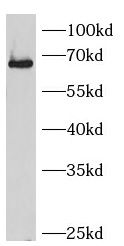Products
SMAD4 antibody
| Synonyms: | Mothers against decapentaplegic homolog 4 (MAD homolog 4 antibody, Mothers against DPP homolog 4)|Deletion target in pancreatic carcinoma 4|SMAD family member 4 (SMAD 4 antibody, Smad4 antibody, hSMAD4)|SMAD4|DPC4|MADH4 antibody | ||
| Catalogue No.: | FNab07995 | Reactivity: | Human, Mouse |
| Host: | Rabbit | Tested Application: | ELISA, WB, IHC, IP |
| Clonality: | polyclonal | Isotype: | IgG |
| Size | Price |
|---|---|
| 100µg | Inquiry |
- SPECIFICATIONS
- FIGURES
- CONDITIONS
- FAQS
- Product Name
- SMAD4 antibody
- Catalogue No.
- FNab07995
- Size
- 100μg
- Form
- liquid
- Purification
- Immunogen affinity purified
- Purity
- ≥95% as determined by SDS-PAGE
- Clonality
- polyclonal
- Isotype
- IgG
- Storage
- PBS with 0.02% sodium azide and 50% glycerol pH 7.3, -20℃ for 12 months(Avoid repeated freeze / thaw cycles.)
- Immunogen
- SMAD family member 4
- Alternative Names
- Mothers against decapentaplegic homolog 4 (MAD homolog 4 antibody, Mothers against DPP homolog 4)|Deletion target in pancreatic carcinoma 4|SMAD family member 4 (SMAD 4 antibody, Smad4 antibody, hSMAD4)|SMAD4|DPC4|MADH4 antibody
- UniProt ID
- Q13485
- Observed MW
- 60-70 kDa
- Tested Applications
- ELISA, WB, IHC, IP
- Recommended dilution
- WB: 1:500-1:2000; IP: 1:200-1:1000; IHC: 1:20-1:200
 HEK-293 cells were subjected to SDS PAGE followed by western blot with FNab07995(SMAD4 antibody) at dilution of 1:600
HEK-293 cells were subjected to SDS PAGE followed by western blot with FNab07995(SMAD4 antibody) at dilution of 1:600
 IP Result of anti-SMAD4 (IP:FNab07995, 4ug; Detection:FNab07995 1:600) with mouse liver tissue lysate 4000ug.
IP Result of anti-SMAD4 (IP:FNab07995, 4ug; Detection:FNab07995 1:600) with mouse liver tissue lysate 4000ug.
 Immunohistochemistry of paraffin-embedded human placenta tissue slide using FNab07995(SMAD4 Antibody) at dilution of 1:50
Immunohistochemistry of paraffin-embedded human placenta tissue slide using FNab07995(SMAD4 Antibody) at dilution of 1:50
- Background
- In muscle physiology, plays a central role in the balance between atrophy and hypertrophy. When recruited by MSTN, promotes atrophy response via phosphorylated SMAD2/4. MSTN decrease causes SMAD4 release and subsequent recruitment by the BMP pathway to promote hypertrophy via phosphorylated SMAD1/5/8. Acts synergistically with SMAD1 and YY1 in bone morphogenetic protein(BMP)-mediated cardiac-specific gene expression. Binds to SMAD binding elements(SBEs)(5'-GTCT/AGAC-3') within BMP response element(BMPRE) of cardiac activating regions(By similarity). Common SMAD(co-SMAD) is the coactivator and mediator of signal transduction by TGF-beta(transforming growth factor). Component of the heterotrimeric SMAD2/SMAD3-SMAD4 complex that forms in the nucleus and is required for the TGF-mediated signaling. Promotes binding of the SMAD2/SMAD4/FAST-1 complex to DNA and provides an activation function required for SMAD1 or SMAD2 to stimulate transcription. Component of the multimeric SMAD3/SMAD4/JUN/FOS complex which forms at the AP1 promoter site; required for synergistic transcriptional activity in response to TGF-beta. May act as a tumor suppressor. Positively regulates PDPK1 kinase activity by stimulating its dissociation from the 14-3-3 protein YWHAQ which acts as a negative regulator.
How many times can antibodies be recycled?
First, usually it's not suggested to recycle antibodies. After use, buffer system of antibodies has changed. The storage condition of recycled antibodies for different customers also varies. Thus, the performance efficiency of recycled antibodies can’t be guaranteed. Besides, FineTest ever conducted the antibody recycling assay. Assay results show recycling times of different antibodies also varies. Usually, higher antibody titer allows more repeated use. Customers can determine based on experimental requirements.
Notes: After incubation, we recycle rest antibodies to centrifuge tube and store at 4℃. High titer antibodies can be stored for a minimum of one week. Reuse about three times.
What are components of FineTest antibody buffer?
Components of FineTest antibody buffer are usually PBS with proclin300 or sodium azide, BSA, 50% glycerol. Common preservative is proclin300 or sodium azide, which is widely applied in the lab and industry.
How about the storage temperature and duration of FineTest antibodies?
Most antibodies are stored at -20℃. Directly-labeled flow cytometry antibodies should be stored at 2 - 8℃. The shelf life is one year. If after sales issues for purchased antibodies appear, return or replacement is available. Usually, antibodies can be still used after the one-year warranty. We can offer technical support services.
Is dilution required for FineTest antibodies? What’s the dilute solution?
Directly-labeled flow cytometry antibodies are ready-to-use without dilution. Other antibodies are usually concentrated. Follow the dilution ratio suggested in the manual. Dilute solution for different experiments also varies. Common antibody dilution buffers are acceptable(e.g. PBST, TBST, antibody blocking buffer).
How to retrieve antibodies for immunohistochemistry?
Common retrieval buffers: Tris-EDTA Buffer(pH 9.0); Citrate Buffer(pH 6.0)
Heat induced antibody retrieval:
Method 1: Water-bath heating: Put the beaker with retrieval buffer and slide in the boiling water bath. Keep the boiling state for 15min. Naturally cool to room temperature;
Method 2: Microwave retrieval: Put the beaker with retrieval buffer and slide in the microwave oven. Heat at high power for 5min, Switch OFF for 3min, Heat at medium power for 5min. Naturally cool to room temperature.
How to choose secondary antibodies?
(1) Secondary antibodies react with primary antibodies. Thus, secondary antibodies should be against host species of primary antibodies. E.g. If the primary antibody is derived from rabbit, the relevant secondary antibody should be against rabbit. E.g. goat anti rabbit or donkey anti rabbit.
(2) Choose secondary antibody conjugates according to the experimental type, e.g. ELISA, WB, IHC etc. Common enzyme conjugated secondary antibodies are labelled by HRP, AP etc. Fluorescin or dye labelled secondary antibodies are applied in immunofluorescence and flow cytometry(e.g. FITC, Cy3).
